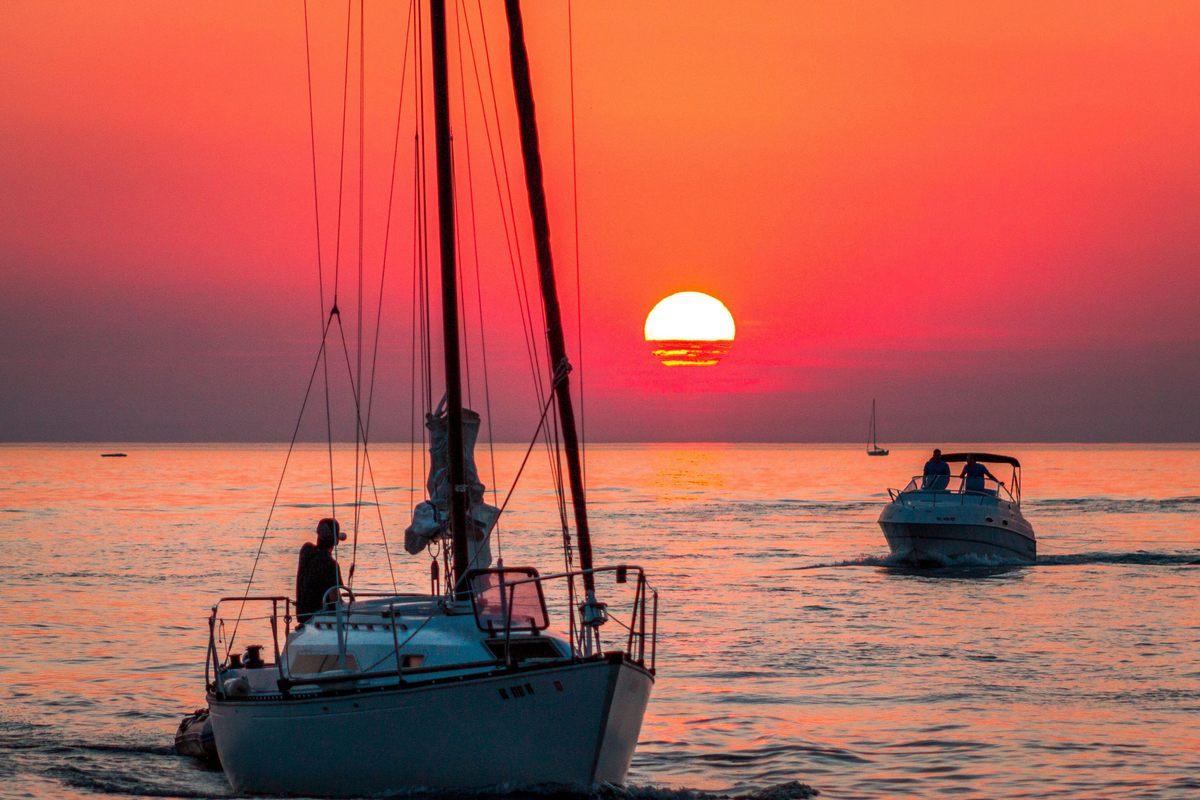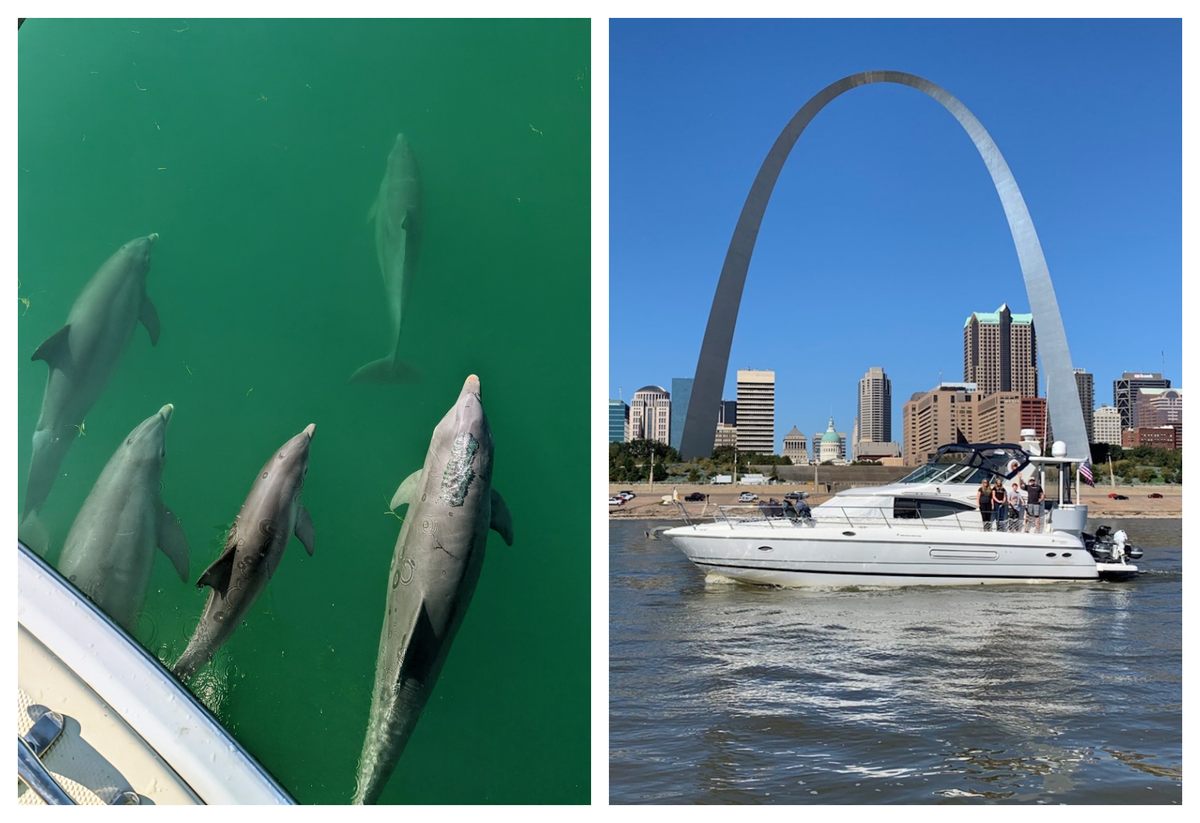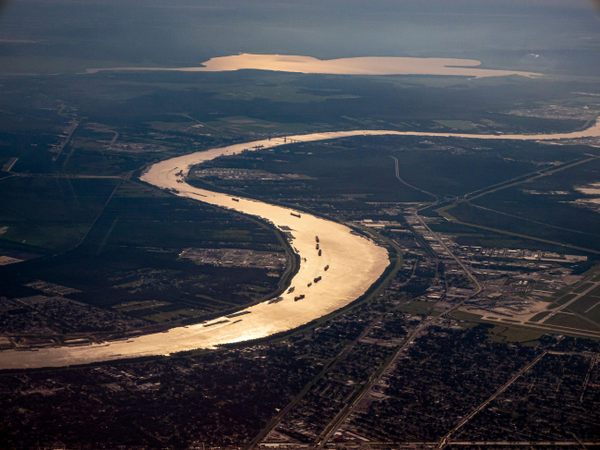Tim and Diane Vandersall were on the open water near Staten Island, New York, when the call came across the radio: “All mariners on the Atlantic Ocean find immediate safe harbor.” A storm was on its way.
All day the water had been choppy on this section of the Great Loop, a series of connecting waterways that encircle the eastern half of the United States. Waves surged against the boat three and four feet high as the horizon turned inky black. A juvenile humpback whale reared up out of the water like a warning.
But the shore was a distant blur and the 40-foot-long Mainship Trawler Wilma May could go only eight miles an hour. They had only one choice: to let the storm wash over them as they sailed towards the port. When the sky shattered, the rain roared so loudly that they had to yell to hear each other from just a few inches away. Water began to pool in the back of the boat. They readied the ditch bag packed with essentials and prepared for the possibility of abandoning ship.
For an hour, they white-knuckled their way across the tides until, finally, the marina rose like a mirage out of the darkness. The Vandersalls had made it through the Great Loop’s only open ocean segment.
“I told our friends after this that I decided I’m adding a flask of vodka for the ditch bag,” laughs Diane Vandersall. And she did, because “if you need the ditch bag, you’re going to need the vodka.”

The Great Loop has been called the last great adventure in North America, a 6,000-mile journey from the Mississippi River to the Gulf Intracoastal Waterways, around Florida and then up the Atlantic coast, across the Erie Canal, and through the Great Lakes. In 2022, only 227 boats returned to their point of origin, “crossing their wake” and earning the privilege of flying the gold Great Loop burgee (flag). Most “Loopers,” traveling in boats at least 30 feet long, took about a year to complete the route. Omaha Nebraska’s Mike Straub completed the loop in just 91 days. He did the whole thing on a Sea-Doo jet ski.
Loopers face a variety of different conditions on the route. In the Southeast, there’s soft muck that can suck a boat into the sand. In the Great Lakes, jagged rocks can slice the hull like butter. “In certain areas, there are significant tide changes and the tide is creating a lot of current,” says Kim Russo, director of America’s Great Loop Cruisers’ Association. And then there are the locks, mechanical devices into which boats must carefully maneuver to pass over hills and waterfalls.
Wind, waves, and weather remain the Loopers’ greatest challenges. Straub barely held on when Lake Michigan’s water turned choppy and the bow of his jet ski was sucked under five to six-foot waves. Seth and Jennifer Voce were on the same lake when a storm sent another boat’s anchor flying and injured its captain. The Voces, including their then 13-year-old son, 16-year-old daughter, and Cavalier King Charles spaniel, made it out of the episode unhurt but had to fix the hull damaged by the rogue anchor.

The Great Loop’s darkest moments, however, pale in comparison to those of beauty and wonder. “There are so many pinch-me moments,” says Seth Voce. “Like when we anchored right behind the Statue of Liberty, or going up the Potomac, we could see the monuments in Washington D.C. and we anchored right at the base of the lawn in Mount Vernon. You just can’t believe you’re there.”
The trip’s highlights vary from traveler to traveler, says Russo. “Whatever your thing is, you’ll find it on the Great Loop. If you’re a history buff, you’ll find it. If you’re a foodie, there are lots of local places. If you like lighthouses, there are plenty to explore. I’ve had members visit every ballpark along the way; one guy played pickleball everywhere he could.” Unusual landmarks—a solitary phone booth on the shore of the Tombigbee River in Alabama, a parade of stuffed zoo animals on a cliff near Panama City, Florida—are “cult favorites” for them all.
But while every Looper is on their own personal odyssey, they are rarely completely alone. The Great Loop isn’t just a journey, it’s a community. Nebo, a social networking and voyage-tracking app, ties Loopers together and buoys them with camaraderie through long days on the water.
“I thought the Great Loop was going to be more about the mountain, about climbing my Mount Everest, and the physical challenge and the emotional challenge of being there,” says Straub, who published a book about his trip, Y Wait: Experience America’s Great Loop, in 2023.

Instead, he discovered a side of humanity he never expected, an entire network of strangers eager to support him on his adventure, from locals who offered him free places to stay to other boaters who’d wait to greet him as he pulled into the marina at night. One afternoon, Straub arrived at a 150-boat raft party in a swirl of cheers and applause from those who’d heard about his journey.
America’s Great Loop Cruisers’ Association is the starting point for those bitten by the Great Loop bug, providing webinars, resources, in-person “Looper Lifestyle” events, and more. Most of those who take on the Great Loop are retirees, but tech and Covid have brought younger adventurers into the fold. “More and more people can work aboard because of more reliable internet, and with working aboard comes more families,” says Russo.
Indeed, the Voces, who began the Loop in June 2022, met a handful of families throughout the 15 months they spent on the water. But even those who had already looped or were planning to loop were crucial connections. “We had instant community with those families and they were lifelines for what we needed,” says Seth. “They were constant resources for us both when we were planning and when we were doing the trip.” Some even met up with the Voces when they came into port or let them borrow a car to get around town.
“This lifestyle gives you a different perspective,” says Tim Vandersall. He and his wife Diane sold their house in Ohio, whittled down their possessions, and made their boat their permanent home before beginning the Great Loop with their Australian shepherd Maggie in November 2022.

At times, the journey felt unreal, like when they traveled alongside a pod of dolphins as they motored from the Florida Everglades to Key West or discovered a restaurant on an island in Ontario Canada’s Georgian Bay only accessible by boat or float plane. But the day-to-day logistical challenges brought them back to reality. “Living on a boat, anywhere you go, if we need groceries, we have to figure out how we are going to do this.” Harbor hosts, guardian angels who live in towns along the Great Loop, are essential for travelers in need of medicine or a ride to a rental car agency.
“Loopers are just so generous and so kind everywhere you go,” says Seth Voce. “It’s the trip of a lifetime and you’re all in it together.” Straub and the Vandersalls agree—and once you’ve been hooked, there’s no time to waste.
“To say you’re going to do this three years from now, something’s going to come up. If you can do it, do it. Don’t put it off,” says Straub. “If I can do this on a Sea-Doo, [maybe] I can at least give others the inspiration to start putting one foot in front of the other.”

